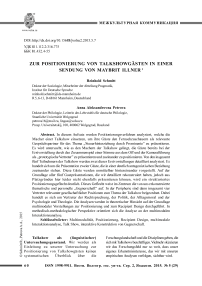Positioning guests in a Maybrit Illner talk show
Автор: Schmitt Reinhold, Petrova Anna Aleksandrovna
Журнал: Вестник Волгоградского государственного университета. Серия 2: Языкознание @jvolsu-linguistics
Рубрика: Межкультурная коммуникация и сопоставительное изучение языков
Статья в выпуске: 5 (29), 2015 года.
Бесплатный доступ
In this paper we analyze techniques applied by the producers of a talk show in order to position the talk show guests as relevant participants with respect to the subject of fiscal evasion by celebrities. We analyze how the producers succeed in positioning their guests right from the beginning as prototypical representatives. This positioning is achieved through the coordination of a voice from offstage and the management of the cameras when the guests first appear on screen. Two of five guest introductions are analyzed in detail. The two presented guests demonstrate a clearly antagonistic relationship and their introduction is immediately consecutive. We have reconstructed the introduction of all five guests in detail which resulted in the identification of a network of positions. Unfortunately we cannot present all of our analyses here due to the lack of space. At the positional network’s center lies the thematic and personal “antagonism” which we reconstructed. At the periphery we have four representatives of societally relevant positions who contribute to the topic of the talk show. The four guests respectively represent jurisdiction, politics, and ethics via a lay perspective, psychology and theology. The analysis is theoretically framed by the multimodal notion of “positioning” and “recipient design”, while the applied methodology is multimodal interaction analysis.
Multimodalität, positionierung, recipient design, multimodale interaktionsanalyse, talk show, interaktive konstruktion von gegnerschaft, multimodality, positioning, multimodal interaction analysis, interactive construction of enmity
Короткий адрес: https://sciup.org/14970390
IDR: 14970390 | УДК: 811.112.2:316.775 | DOI: 10.15688/jvolsu2.2015.5.7
Текст научной статьи Positioning guests in a Maybrit Illner talk show
DOI:
Schlüsselwörter: Multimodalität, Positionierung, Recipient Design, multimodale Interaktionsanalyse, Talk Show, interaktive Konstruktion von Gegnerschaft.
Talkshow als (linguistischer) Untersuchungsgenstand. Wir werden als Einleitung zu unserer Untersuchung zur Positionierung von Talkshowgästen keinen systematischen Überblick über die
Forschungslandschaft und die Disziplinen geben, die sich mit Talkshows beschäftigen. Vielmehr skizzieren wir das Forschungsfeld nur so weit, dass unser eigenes Erkenntnisinteresse, das wir mit unseren empirischen Analysen verfolgen, sichtbar wird.
Talkshows sind seit längerer Zeit Bestandteil unserer (medialen) Alltagskultur, und die Wissenschaft hat sich frühzeitig mit ihnen beschäftigt und sie zum Gegenstand gesellschaftsreflexiver Auseinandersetzung gemacht. Dabei wurden ihre „Konzeption und Funktion“ untersucht [12], die gesellschaftlichen Auswirkungen eingeschätzt und diskutiert [23; 34], die „Industrialisierung der Kommunikation“ konstatiert [31], „das große Rhabarbern” beklagt [7], die Frage nach der Qualität der Talkshow im Spannungsfeld von „Geschwätz oder Diskurs“ gestellt [47], deutsche und amerikanische Talkshows zwischen den Polen „Talk als Show – Show als Talk“ verglichen [53], die Omnipräsenz des Sendeformats als „Talk auf allen Kanälen” festgehalten [58], die Talkshow als „umstrittenes TV-Format“ zur Diskussion bzw. an den Pranger gestellt [6] und die „ersten zehn Jahre“ eines bestimmten Formats gefeiert [2].
Speziell die linguistische Beschäftigung mit Talkshows konzentriert sich auf eine Vielzahl ganz unterschiedlicher Aspekte und erfolgt auf der Grundlage sehr heterogener Erkenntnisinteressen. Die linguistische Forschung untersucht Talkshows beispielsweise aus einem allgemeinen typologischen Interesse heraus, das um die mediale Spezifik von Kommunikation kreist. So nutzt sie Talkshows als empirische Basis für die Rekonstruktion konstitutiver Aspekte medialer Dialogsorten [13; 16] und für die typologische Klärung von Gesprächsformen im Fernsehen [4]. Auch geht es darum, die Talkshow gegenüber anderen, medienspezifischen Dialogformen kontrastiv zu präzisieren [26].
Bei einem dezidiert interaktionistischen Erkenntnisinteresse wiederum stehen solche Aspekte im Vordergrund, die aufgrund ihrer medialen Inszenierung von besonderem analytischen Interesse für allgemeine Fragen der Interaktionskonstitution sind. Hier geht es beispielsweise um medienspezifische Formen der Beziehungskonstitution und um Imagestrategien [18; 29], um kooperative und antagonistische Verfahren der Themenetablierung, Themenbehauptung und Themenkontrolle [3; 17; 19]. Des Weiteren steht unter einer gesprächsrhetorischen Erkenntnisperspektive die Analyse spezifischer Interaktionsmodalitäten (beispielsweise das „Forcieren” als Durchsetzungsstrategie von Nicht-Experten) im Fokus [22].
Die Untersuchung interaktionskonstitutiver Aspekte im Medium des Fernsehens und konkret auf der Grundlage von Talkshows lässt sich als bunter Strauß von Untersuchungsaspekten weiter aufblättern. Es existieren Analysen zum Frageverhalten und zur Wortwahl (hauptsächlich) von Moderator/innen [20], zu geschlechtsspezifischem Verhalten [57], zu Formen des medienspezifischen Sprachgebrauchs [8] und zur Bedeutung von Berührungen [11].
Von solchen mono-aspektuellen Untersuchungen unterscheiden sich Arbeiten, die sich mit der Frage beschäftigen, welche formatspezifischen Potenziale gerade Talkshows aufgrund ihres Inszenierungscharakters als „subjektkonzentrierte Diskursform” besitzen und welche interaktiven Formen und Verfahren deswegen entstehen (können) [51].
Wieder andere Arbeiten fragen nach Strategien und Verfahren, die eingesetzt bzw. gefördert werden, um in der medialen Öffentlichkeit der Talkshow Intimität zu konstituieren [14; 32]. Auch die medienspezifischen Voraussetzungen der Talkshow für die Identitätskonstitution stehen im Fokus analytischer Investigation [5]. Vereinzelte Arbeiten fragen auch nach spezifischen – mit dem Talkshowformat untrennbar verbundenen – Anforderungen für die Macher der Sendungen und der Art und Weise, wie diese bearbeitet werden. Dazu gehört beispielsweise das für den problemlosen Ablauf der Sendung notwendige Interaktionsmanagement der Moderator/innen [30].
Wir selbst versuchen, die Präsentationsarbeit der Talkshow-Macher auf der Grundlage dessen zu rekonstruieren, was die Zuschauer an den Bildschirmen zu sehen bekommen. Wir sind also daran interessiert, in dem fertigen und gesendeten Format den Inszenierungscharakter der Talkshow aufzuspüren und an bestimmten Aspekten empirisch nachzuweisen. Wir stellen dazu die Frage: Wie werden die Gäste der Show, die ja einen Großteil des Talks liefern sollen, den Zuschauern von den Machern der Sendung präsentiert? 2
Wir gehen dabei von folgender Grundvorstellung aus: Eine Talkshow ist eine Fernsehsendung, in der für die Zuschauer relevante Aspekte und Perspektiven zu einem ausgewählten Thema präsentiert werden, das über eine gewisse gesellschaftliche bzw.
öffentliche Bedeutung sowie über eine gewisse Aktualität verfügt. Dazu werden Gäste eingeladen, die zum Thema der Sendung eine erkennbare Position oder Meinung haben bzw. von denen die Sendungsmacher davon ausgehen, dass dies der Fall ist. Damit es für die Zuschauer interessant, unterhaltsam und informativ wird, sind diese Gäste nicht selten Vertreter widerstreitender Positionen.
Eine wichtige Voraussetzung dafür, dass Talkshows im Sinne der Fernsehunterhaltung funktionieren, ist die Auswahl der richtigen Gäste. Die Talkshowgäste sind primär nicht als Individuen interessant, sondern werden als Vertreter typischer und zum Großteil auch erwartbarer Positionen (beispielsweise: pro und contra etc.) eingeladen. Es handelt sich zudem um Personen, die in der Regel Erfahrung im Umgang mit Medien haben. Sie sind nicht selten Talkprofis in dem Sinne, dass es zu ihrem Beruf oder ihrer gesellschaftlichen Rolle gehört, sich „medienwirksam” zu präsentieren und die eine gewisse Affinität zur medialen Öffentlichkeit haben 3.
Die Fragestellung. Mit dieser Grundbestimmung von Talk als Show und vor allem der Gäste als typische, das heißt erkennbare Vertreter von Positionen zum Thema der Sendung hängt eine wichtige Anforderung der Talkshowmacher zusammen. Sie können sich nicht fraglos darauf verlassen, dass die Zuschauer auf Anhieb verstehen, welche Haltung die einzelnen Gäste zum Thema der Sendung haben. Sie müssen vielmehr von einer Art struktureller Perspektivendivergenz zwischen ihrer Sicht auf die Gäste und der Wahrnehmung dieser Gäste durch die Fernsehzuschauer ausgehen. Sie stehen also von Beginn an vor der Aufgabe, auch den Zuschauern genau die prototypische Qualität der Gäste verdeutlichen, die für sie in der Vorbereitung der Sendung bei der Auswahl und Zusammensetzung der Gäste ausschlaggebend war 4.
Wir nennen die Perspektivendivergenz eine strukturelle, weil sie auf eine nicht aufhebbare Differenz zwischen den Machern der Sendung und den Fernsehzuschauern verweist. Letztere haben zur Vorbereitung und den damit verbundenen Überlegungen, wer bezüglich des Themas ein geeigneter Gast wäre, und welche Zusammensetzung von Gästen denn die Erfolg versprechende ist, keinen oder nur sehr beschränkten Zugang 5. Sie lernen die Gäste erst in der Sendung kennen, während die Macher die Positionen jedes einzelnen Gastes zum Thema genau kennen. Die Talkshow-Macher beheben diese strukturelle Perspektivendivergenz, indem sie den Zuschauern die ausgewählten Gäste in ihrer Qualität als relevante Vertreter bestimmter Positionen präsentieren. Mit der Frage, mit welchen Verfahren und Ressourcen die einzelnen Gäste dabei positioniert werden, beschäftigt sich unsere Analyse.
Theoretische Grundlagen: Positionierung und Recipient Design. Unser theoretischer Rahmen speist sich durch konzeptionelle Überlegungen zur „Positionierung” [9; 10] und zum multimodalen „Recipient Design“ [44; 45] 6. Beide Ansätze gehen im Kern davon aus, dass Interaktionsbeteiligte durch ihr Verhalten andere Anwesende oder Personen, über die gesprochen wird, unweigerlich in sozial relevanter Weise charakterisieren, klassifizieren und positionieren. Besonders deutlich wird das bei Formen, in denen explizite soziale Kategorien verwendet werden. Dies geschieht, wenn Interaktionsbeteiligte diesen Kategorien verbal explizit zugeordnet werden bzw. wenn ihnen mit den Kategorien verbundene soziale Eigenschaften und Erwartungen zugeschrieben werden (beispielsweise [38; 59]). Zum zentralen Gegenstand wurde die Analyse solcher kategorialen Zuschreibungen für die auf Sacks [37] zurückgehende membership categorization analysis (beispielsweise [55] und [56]). Beide Ansätze stimmen auch darin überein, dass die sozial relevante Zuschreibungsaktivitäten reflexiver Natur sind und somit immer bi-direktional zu rekonstruieren sind. Soziale Zuschreibungen, welcher Art auch immer, sind implikativ im Hinblick auf Fremd- und Selbstpositionierung. Und auch das Recipient Design verweist immer auch reflexiv auf den jeweiligen Designer, der sich immer auch selbst sozial charakterisiert durch die Art und Weise, wie er andere mit seinem eigenen Verhalten positioniert.
Die Ansätze unterscheiden sich jedoch hinsichtlich ihrer empirischen Grundlagen. Der Positionierungsansatz, der aus der Analyse narrativer Strukturen hervorgegangen ist (beispielsweise [27]), ist primär monomodal, das heißt verbal gegründet. Bei Überlegungen zum Recipient Design im Rahmen der multimodalen Interaktionsanalyse 7 stellt Verbalität nur eine der Ausdrucksressourcen dar, die den Interaktionsbeteiligten zur Verfügung stehen. Als
Konsequenz dieser multimodalen Neuorientierung hängt eine Vorstellung der kontinuierlichen und multimodal realisierten Positionierung zusammen. Bei ihr wird dann der gesamte Bereich des audio-visuell wahrnehmbaren Verhaltens „design-verdächtig” und damit zum Gegenstand der Positionierungsanalyse. An anderer Stelle [44, S. 246] ist dieser Sachverhalt als „kontinuierliche Repräsentanz des Anderen im eigenen Verhalten” wie folgt formuliert:
„In der Art und Weise, wie wir in seiner Gegenwart grundlegende interaktive Anforderungen bearbeiten, ob und wie wir auf gemeinsames Wissen zurückgreifen oder dieses fraglos unterstellen, als wen wir unser Gegenüber sozial „sehen” und einschätzen, ob und wie wir uns selbst mit unserem Gegenüber in Beziehung setzen etc., drückt sich – ob wir wollen oder nicht – in unterschiedlichen Aspekten unseres interaktiven Gesamtverhaltens aus. Zu interagieren bedeutet in diesem Sinne, unser Gegenüber (und uns selbst) kontinuierlich in unserem Verhalten zu repräsentieren“.
Bei unseren nachfolgenden Analysen der Präsentation der Talkshow-Gäste spielt gerade auch der Aspekt der visuell wahrnehmbaren Positionierung der Gäste durch die Kameraführung eine wesentliche Rolle. Wenn bereits in alltagsweltlich-authentischen Situationen die Positionierung oder die Repräsentanz des anderen im eigenen Verhalten zentraler Bestandteil der Interaktionskonstitution sind, dann gilt das in zugespitztem Ausmaß bei Talkshows als spezifischem Sendeformat bezogen auf die Präsentation der Gäste. Denn hier besteht die Kunst gerade darin, die Gäste als spezifische, als klar zuordenbare und als sozial charakterisierte dem Zuschauer anzubieten und näherzubringen. Die Positionierung oder das Recipient Design der Gäste ist also das Ergebnis einer bewussten und systematischen Präsentation der Gäste durch die Talkshow-Macher. Bei unserer Analyse konzentrieren wir uns also auf das, was die Macher selbst in der Vorstellungsrunde über ihre Gäste sagen und fokussieren dabei in gleichwertiger Weise auch den Beitrag, den die Kameras dabei leisten.
Die Talkshow „Uli Hoeneß” von Maybrit Illner. In der konkreten Talkshow 8, aus der wir unsere Ausschnitte für die Analyse ausgewählt haben, geht es um Uli Hoeneß, den ehemaligen Vorsitzenden des Fußballvereins Bayern München. Hoeneß hatte sich, nachdem bereits sehr lange in den Medien über eine Steuerhinterziehung spekuliert wurde, in einer Selbstanzeige der Steuerhinterziehung in Millionenhöhe bezichtigt. Diese Selbstanzeige erfolgte zu einem Zeitpunkt, zu dem sich die öffentlichen Mutmaßungen verdichteten, und wohl in der Hoffnung, dadurch einem Prozess und einer damit zusammenhängenden Gefängnisstrafe zu umgehen. Der Prozess wurde jedoch eröffnet und Hoeneß wurde am Ende dieses – von der Öffentlichkeit viel beachteten Prozesses – zu dreieinhalb Jahren Haft verurteilt.
Die analysierten Ausschnitte. Empirische Grundlagen unserer Untersuchung sind Ausschnitte, die aus der Anfangsphase der Sendung stammen 9. Während sich die Zuschauer im Laufe der Zeit einen Eindruck von einem Gast verschaffen, indem sie seine Beiträge insgesamt als für eine bestimmte Position stimmig (oder auch widersprüchlich) wahrnehmen und interpretieren, sind die Voraussetzungen dafür am Anfang nicht gegeben. Die Macher der Talkshow machen den Zuschauern durch die Vorstellung der Gäste und durch die Struktur der Einzelpräsentation Angebote, die expliziten und impliziten Positionierungen zu übernehmen und die Gäste in dem damit zusammenhängenden Geflecht von Beziehungen zu sehen. Solche Beziehungen lassen sich beispielsweise kategorial fassen als „Experte“, „Freund“, „Betroffener“, „Sympathisant“, „Gesetzesvertreter“, „Journalist“ oder „Politiker“.
Die Erst-Präsentation der Gäste aus dem Off. Nach Eröffnung der Talkshow durch die Moderatorin und die Einführung in das Thema der Sendung werden alle am Tisch sitzenden Gäste (Bild 1) steckbriefartig vorgestellt. Dabei wird deren Beruf und/oder ihr spezifisches Verhältnis zu Uli Hoeneß oder ihre allgemeine Kompetenz für das anstehende Thema mit den dazugehörenden Positionen und Perspektiven mitgeteilt. Der kurze, maximal komprimierte Steckbrief übernimmt die Aufgabe, die Expertise der Gäste zu behaupten und zu erklären, warum gerade sie zur Talkshow eingeladen wurden.
Wir beginnen unsere Analyse, indem wir zunächst danach fragen, wie die Gäste kameratechnisch präsentiert werden und was man – allein aufgrund des dabei vermittelten visuellen Eindrucks – über die Gäste erfährt.
Die visuelle Positionierung der Gäste bei der Vorstellung. Bei der Vorstellungsrunde arbeitet die Kamera nach einem bestimmten Schema: Am Beginn der Vorstellung sind alle in einer sitzenden Brust-Portrait-Einstellung zu sehen. Am Ende des Steckbriefs hat die Kamera die Personen fast in einer Portraiteinstellung herangezoomt und somit den Zuschauern – im wahrsten Sinne des Wortes – bereits etwas nähergebracht (Bild 1 bis 8).
Unabhängig von der jeweiligen Kameraposition (ob sie den Gast eher frontal oder etwas links von der Seite erfasst) stimmen die Startbilder und die Endpunkte der Zoomdynamik bei allen vier Personen überein. Im Rahmen dieser Systematik der kameraseitigen Präsentation gibt es jedoch zwei Ausnahmen: einen minimal und einen maximal kontrastierenden Fall.
Das ist zum einen die Präsentation des ehemaligen Bayernspielers Olaf Thon. Zwar stimmt auch bei ihm das Startbild, das ihn bei Beginn seiner Vorstellung zeigt, mit dem der andern Gäste überein. Er wird jedoch erkennbar weniger deutlich ins Portrait gezoomt als die anderen am Tisch sitzenden Personen. Er wird sozusagen weniger nah an die Zuschauer herangeführt und bleibt für diese eher in einer Mitteldistanz (Bild 9, 10) 10.
Startbild (der Präsentation)
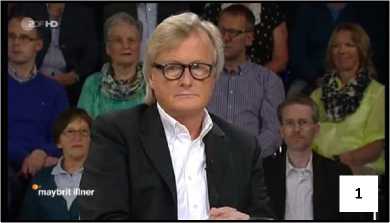
Endbild (der Präsentation)
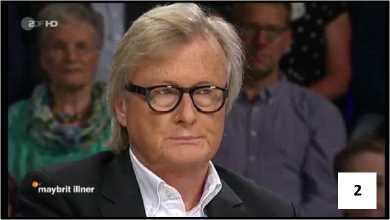
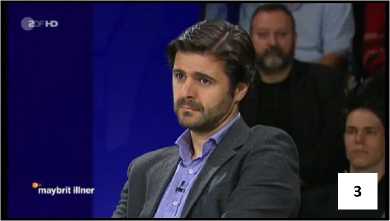
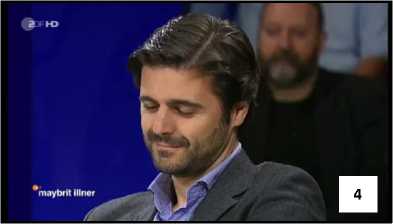
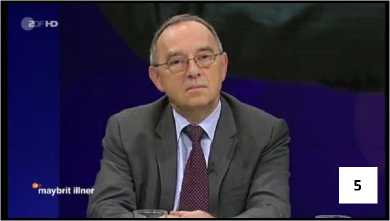
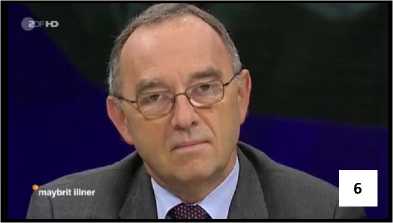
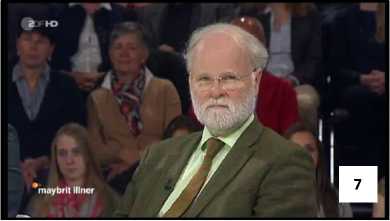
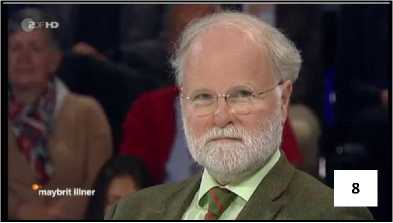
Die zweite Abweichung mit deutlich maximaler Kontrastivität ihrer Präsentation ist Simone Kemper, eine ehemalige Staatsanwältin, die nun als Verteidigerin in Steuerprozessen tätig ist. Sie sitzt nicht mit am Tisch, sondern etwas abseits unten in der ersten Zuschauerreihe im Publikum (Bild 11, 12).
Betrachtet man das Startbild links (Bild 11), weiß man zunächst nicht, welche der drei in der ersten Reihe sitzenden Frauen die fragliche Expertin überhaupt ist. Dies wird erst mit der einsetzenden Zoombewegung während ihrer Vorstellung wirklich deutlich. Anders als bei den anderen Gästen holt die Kamera sie von weiter ab und sie wird zudem – wie Thon – nicht in eine wirkliche Portraiteinstellung gezoomt. Ihr Bild am Ende ihres Steckbriefs (Bild 12) entspricht in etwa dem Startbild der anderen Gäste. Mit anderen Worten: Sie ist für die Kamera und die Zuschauer zunächst weiter weg und wird am Ende der Zoombewegung den Zuschauern auch nicht wie die anderen Gäste wirklich nahegebracht.
Ihr besonderer Status als Expertin wird also durch ihre räumliche Positionierung im Zuschauerbereich und damit weit weg vom Tisch als dem interaktiven Zentrum der Talkshow verdeutlicht. Die Kamera müsste sie jedoch nicht zwangsläufig in ihrer räumlichen Position zeigen, sondern könnte – genau wie bei den andern Gästen – mit der gleichen Portrait-Brust-Einstellung starten. Die Kamera arbeitet also subtil während ihrer Vorstellung an ihrer Positionierung mit. Auch die Art und Weise ihrer visuellen Präsentation macht ihren randständigen Gästestatus deutlich: Sie gehört nur peripher dazu und hat aufgrund ihrer zunächst körperlich-räumlichen Positionierung bei den Zuschauern keinerlei Möglichkeit, sich interaktiv am Gesprächsgeschehen zu beteiligen. Als sie gegen Ende der Sendung zu Wort kommt, steht sie zusammen mit der Moderatorin an einer Art Bistrotisch, der extra herbeigeschafft und im Zuschauerbereich in unmittelbarer Nähe zu ihrem Sitzplatz postiert wird (Bild 13).
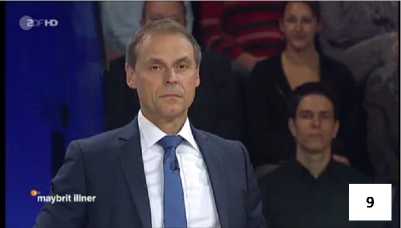
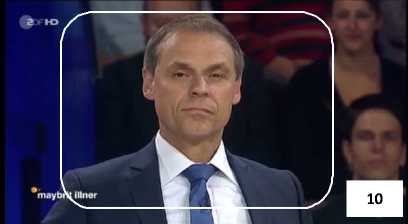

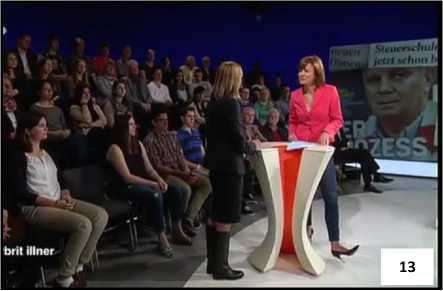
Auf den ersten Blick haben wir es also mit einer Zweiklassengesellschaft von Gästen zu tun, die wir bislang primär aufgrund ihrer visuellen Positionierung durch die Studiokameras rekonstruiert haben: Männer, die zusammen am runden Tisch sitzen, und eine Frau, die zwar ebenfalls als Expertin eingeladen ist, jedoch im Bereich der Zuschauer positioniert ist 11. Hinsichtlich der Männerrunde wiederum scheint ein Gast, nämlich Olaf Thon, der ehemalige Bayernspieler, ebenfalls etwas aus der Rolle zu fallen. Wobei dies bei ihm wesentlich subtiler bewerkstelligt wird.
Nach diesem ersten visuellen Eindruck wollen wir uns nun genauer anschauen, was über die Gäste in der Vorstellungsrunde gesagt wird. Wir werden dabei jedoch unseren visuellen Ersteindruck mitnehmen und ihn bei der Rekonstruktion der verbalen Vorstellung kritisch hinterfragen.
Die verbale Positionierung der Gäste mittels Steckbriefen. Bei der Reihenfolge der Gästevorstellung fällt auf, dass sie keiner für die Zuschauer erkennbaren Orientierung folgt, denn weder geht es reihum (also von links nach rechts oder umgekehrt) noch geht es alphabetisch zu. Vielmehr scheint die Logik der Abfolge einem impliziten Positionierungskonzept zu folgen, das nicht offen kommuniziert wird. Dieses Konzept scheint der Etablierung von Freund- und Gegnerschaft, von Nähe und Distanz bezogen auf die Person Uli Hoeneß zu folgen.
Als erstes wird nämlich ein Freund des Verurteilten mit den Worten vorgestellt: HANS ulrich jörges (-) der sternjournalist ist mit uli hoeneß befreundet , (Zeile 22-24). Dann folgt ein Journalist, der ein sehr kritisches Buch über Hoeneß geschrieben hat, und den man aufgrund dieser Publikation nicht ebenfalls als Freund verstehen kann: JUan moreno der spiegelautor stellt fest (.) hoeneß hat ALle belogen (Zeile 31-34). Damit ist mit den ersten beiden Gästen bereits die für Talkshows strukturkonstitutive Pro-und Kontraposition besetzt. Durch die explizite und implizite Kategorisierung HANS ulrich jörges ist mit uli hoeneß befreundet und JUan moreno der spiegelautor stellt fest (.) hoeneß hat ALle belogen sind für die Zuschauer eine antagonistische Positionierung dieser beiden Gäste verbunden und wecken unweigerlich bestimmte Erwartungen hinsichtlich ihrer Beteiligungsweise.
Ist diese positionale Grundstruktur geleistet, können die anderen Gäste, die nicht so klar in ihrem Verhältnis zu Hoeneß charakterisiert werden, ebenfalls präsentiert werden. Wie genau dies geschieht, wollen wir im Folgenden rekonstruieren und starten mit dem ersten Gast, der vorgestellt wird, dem Journalisten Hans Ulrich Jörges. Was erfahren wir von der Stimme aus dem Off über ihn und sein Verhältnis zu dem Verurteilten?
Gast 1: Hans-Ulrich Jörges (Journalist beim Stern). Wir wollen die Rekonstruktion seines Steckbriefs auch zur Beantwortung der Frage nutzen, ob sie wie die visuelle Präsentation der Kamera ebenfalls einer Systematik folgt. Gibt es also rekurrente Aspekte, die bei allen Gästen realisiert werden? Wir starten mit einer fallanalytischen Rekonstruktion, indem wir uns sequenziell durch den Steckbrief des ersten Gastes arbeiten.
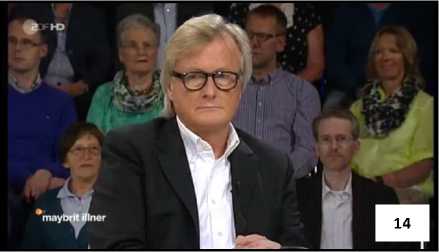
22 SO12: HANS ulrich jörges (-)
Zunächst wird der Gast, der mit ernstem Gesichtsausdruck nach rechts an der ihn aufnehmenden Kamera vorbeiblickt, namentlich vorgestellt. Dabei „fehlt” eine einleitende Äußerung wie etwa „unser erster Gast ist”. Die sofortige Namensnennung vermittelt den Eindruck, es gehe unmittelbar zur Sache und man halte sich nicht lange mit Vorgeplänkel auf. Zum andern macht die „einführungslose” Vorstellung die Etablierung eines Musters erwartbar, das sich auch bei der Vorstellung der anderen Gäste wiederholen wird. Es wäre auffällig, würde der zweite Gast mit einer einleitenden Bemerkung „unser zweiter Gast ist“ vorgestellt.
23 SO: der sternjournalist ist 24 mit uli hoeneß befreundet
Die zweite Information über den Gast besteht aus zwei Teilen, die jedoch segmental nicht als eigenständige Teile realisiert werden. Zum einen ist das die Berufsbezeichnung der sternjournalist . Die Verwendung des bestimmten
Artikels der in einem prädikationsfreien Kurzformat impliziert die Bekanntheit des Berufes von Herrn Jörges. Sein Beruf als Journalist könnte ihn also in die Talkshow geführt haben, und wir dürften dann professionsspezifische Beiträge des Gastes erwarten. Diese Positionierung als professioneller Journalist wird jedoch mit einer neuen Information relativiert. Denn nun erfahren wir, dass der Gast mit uli hoeneß befreundet ist. Er ist also nicht nur Vertreter der (über Hoeneß) schreibenden Zunft, sondern auch Privatperson, die mit Hoeneß, über den seine Kollegen schreiben, freundschaftlich verbunden ist. Das positioniert ihn in einem interessanten Spannungsverhältnis von professionell-kritischer Distanz zum wegen Steuerhinterziehung Verurteilten und freundschaftlich-unterstützender Nähe zur Person Uli Hoeneß.
25 SO: und sagt (--) er ist ein
26 steuerhinterzieher
-
27 (.) aber gleichzeitig
-
28 der sozialste mensch den ich
-
29 kenne
Die nächste Information, die durch das intonatorisch angebundene und sagt projiziert ist, kann man als Exemplifizierung dieses Spannungsverhältnisses sehen. In der Form eines Zitates, das durch und sagt dem Gast als Autor zugeschrieben wird, werden nunmehr die Implikationen, die sich aus der spannungsreichen Positionierung ergeben, benannt. Die Formulierung er ist ein steuerhinterzieher erfolgt aus der Position der journalistischen Distanz. Sie behandelt Uli Hoeneß kategorial als Steuerhinterzieher, wodurch er mit allen Mitgliedern dieser Kategorie vergleichbar wird. Der zweite Zitatteil ist in seiner Eigenständigkeit durch die segmentale Gliederung der Sprechpause (.) und in ihrer hochgestuften Relevanz gegenüber der vorherigen Kategorisierung durch das adversative aber deutlich markiert 13. Sie erfolgt nun aus der Perspektive des Freundes und wird vor allem durch den ich kenne als persönliches Statement deutlich gemacht. Im ersten Äußerungsteil suchen wir eine vergleichbare Referenz auf den Autor vergeblich. Es ist diese Gleichzeitigkeit der beiden Perspektiven, für die der Gast steht und von den Machern der Sendung angekündigt wird. Und es ist der Widerspruch, dass Steuerhinterzieher soziale Menschen sind/ sein können, die den Zuschauer gespannt sein lassen (können), und die Art und Weise, wie der Gast diesen Widerspruch in das Gespräch einbringen wird, die ihn als interessanten Gast ausweist.
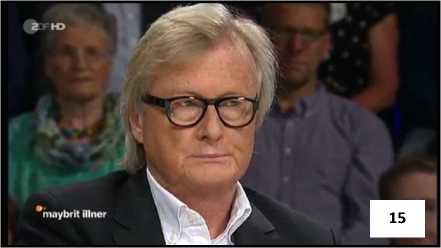
30 (2.0)
Der Kurzsteckbrief ist damit auch schon zu Ende. Der Zuschauer kann jedoch noch für zwei Sekunden in das nun bildschirmfüllende Gesicht des Gastes blicken. Nicht zuletzt in der spannungsvollen und widerstreitenden Positionierung des Gastes – der Hoeneß als Journalist als Steuerhinterzieher, als Privatperson und Freund jedoch als sozialsten Menschen charakterisiert – kann man einen Grund für dessen ernste Mimik sehen. Von ihm kann der Zuschauer Gesprächsbeiträge erwarten, die genau zwischen diesen beiden Polen oszillieren. Das ist das zentrale Ergebnis unserer Rekonstruktion des Kurzsteckbriefes von Hans Ulrich Jörges: Die Positionierung, welche die Macher für diesen bei seiner ersten Begegnung mit den Zuschauern vorgesehen und realisiert haben, bedeutet: Für den Gast ist Hoeneß beides: Steuerhinterzieher und Sozialmensch.
Die Struktur, die der Vorstellung zugrunde liegt, besteht in chronologischer Abfolge aus folgenden Aspekten:
-
1) Namensnennung,
-
2) Berufsbezeichnung (mit Nennung der Illustrierten, für die gearbeitet wird),
-
3) Charakterisierung der Beziehung zu Uli Hoeneß und
-
4) Zitat, das den Gast in seiner Haltung gegenüber Uli Hoeneß charakterisiert.
Schauen wir uns nun die Vorstellung des zweiten Gastes an. Auch hier werden wir uns wieder schrittweise durch den Kurzsteckbrief arbeiten, dabei jedoch neben der fallanalytischen Perspektive auch bereits den Vergleich mit der Präsentation des ersten Gastes im Auge behalten.
Gast 2: Juan Moreno (Journalist beim Spiegel und Autor)
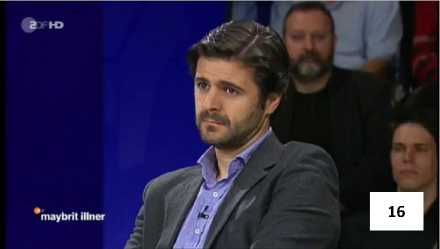
31 SO: JUan moreno
Auch der zweite Gast wird – wie bereits vermutet – ohne einleitende Floskeln namentlich vorgestellt JUan moreno . Die Kamera zeigt ihn etwas von rechts wie er nach vorne blickt in Richtung der Kamera, welche die Gäste erstmalig gezeigt hatte. Seine Augen sind weit offen, sein Gesicht ist ernst und er hat seine Stirn in Falten gezogen.
32 SO: der spiegelautor stellt 33 fest (.)
Wie beim ersten Gast, so folgt als nächste Information auch bei ihm die Angabe des Berufes. So erfahren wir sofort nach seinem Namen, dass die beiden ersten Gäste Berufskollegen sind. Interessant ist dabei, dass auch hier das gleiche Format der Berufsbezeichnung benutzt wird: der bestimmte Artikel der und den Zusammenzug der Professionsbezeichnung und des Nachrichtenmagazins, für das der Gast arbeitet: der spiegelautor (der sternjournalist bei Gast 1).
Dann wird der projektive Beginn einer Folgeäußerung stellt fest , die erkennbar nicht mehr zur Berufsbezeichnung gehört, intonatorisch integriert (und ebenfalls wie bei Jörges nicht segmental als eigenständig markiert). Projiziert wird mit stellt fest im Gegensatz etwa zu sagt das Ergebnis einer ernsthaften Überlegung, eines längeren Reflexionsprozesses oder einer gewissenhaften Prüfung. Wir erwarten auf keinen Fall eine schnelle, gerade eben erst getroffene Einschätzung. Es ist zu vermuten, dass die Feststellung, von der wir noch nicht wissen, welchen Inhalt sie hat, im Zusammenhang mit der journalistischen Profession des Gastes steht.
34 SO: hoeneß hatt ALle belogen (-)
Nach einer kurzen Pause wird dann die projizierte Feststellung – vergleichbar dem Zitat des ersten Gastes über seine Haltung gegenüber
Hoeneß – als autorisiertes Zitat des Gastes formuliert und Hoeneß dabei als Lügner bezeichnet ( hoeneß hatt ALle belogen ). Zwei Dinge sind hinsichtlich dieser neuen Information, die wir über den zweiten Gast erhalten, interessant. Zum einen wird auf eine explizite Charakterisierung seines Verhältnisses zu Hoeneß verzichtet, zum anderen wird, wenn man dieses Zitat ernst nimmt, auch der mit Hoeneß befreundete Sternjournalist zu den Opfern von Hoeneß. Implizit wird damit die zweite, im hochgestuften Aber-Teil formulierte soziale Qualität von Hoeneß massiv bestritten. Grundsätzlich wird mit dieser Feststellung behauptet, Hoeneß habe ein öffentliches Bild von sich vermittelt, das in keiner Weise mit der Realität übereinstimmt, mit der sich – so können wir vermuten – der Spiegeljournalist eingehend beschäftigt hat. Er ist sozusagen derjenige, der die Lüge entlarvt hat, der alle anderen, die mit Hoeneß zu tun hatten, erlegen sind. Das gilt dann natürlich auch für den mit Hoeneß befreundeten Sternjournalisten Jörges.
Wir sehen also, wie sich die Kurzpräsentationen der ersten beiden Gäste immer stärker auf eine polarisierende Positionierung der beiden hinarbeiten, die sie zwangsläufig in Opposition bringt. Dabei werden bereits bei der zweiten Vorstellung – aufgrund ihrer zeitlichen Nähe zur unmittelbar vorangegangenen Vorstellung – dort formulierte Informationen als kontrastive Bezugspunkte genutzt. Allgemeiner formuliert kann man sagen: Die Macher nutzen bei der Positionierung des zweiten Gastes implizit Aspekte der Positionierung des ersten Gastes. Da dafür aber unmittelbare nahzeitliche Kontextbedingungen Voraussetzung sind, können wir nun auch verstehen, dass die Macher der Talkshow nicht zufällig genau diese beiden Gäste in der hier vorliegenden Abfolge präsentieren. Wir haben damit also empirische Evidenz für die Funktionalität der Vorstellungsabfolge erhalten und können begreifen, dass nichts, aber auch gar nichts an der Talkshow dem Zufall überlassen bleibt oder gar der emergierenden Struktur authentischer Interaktionskonstitution folgt. Hier nutzen die Macher der Talkshow die mit der kontextuellen Unmittelbarkeit verbundenen kontrastiven Bezugsmöglichkeiten und sorgen dafür, dass bei der zweiten Vorstellung die erste immer als relevanter Verstehenshintergrund relevant gehalten wird. Anders formuliert: Wir können sehen, dass und wie die beiden Positionierungen bis ins Detail miteinander verwoben sind.
35 SO: geld alLEIN ist für ihn
36 der maßstab des erfolgs
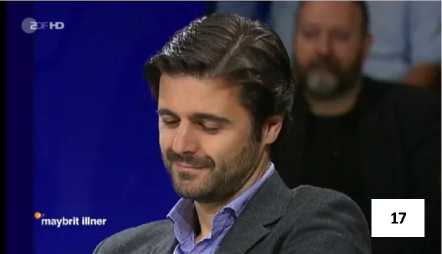
37 (2.0)
Dies wird besonders beim letzten Teil des Zitats Morenos deutlich. Hier wird formuliert, wie aus seiner Sicht die Realität von Hoeneß wirklich aussieht – und damit auch implizit, was die Lüge war. Das Zitat geld alLEIN ist für ihn der maßstab des erfolgs ist zunächst nicht eindeutig als Gegenstück zur Lüge identifizierbar. Denn mit der Hoeneß dabei zugeschriebenen Haltung, Geld sei der alleinige Maßstab für Erfolg, steht dieser sicherlich nicht allein. In einer auf Kapitalisierung und Gewinnmaximierung ausgerichteten und propagierten Welt ist das ein durchaus gängiges Glaubensbekenntnis oder bekannte propagandistische Floskel. Das hängt ganz vom Sandpunkt ab, den man selbst diesbezüglich einnimmt.
Es ist also sicher nicht die – vielleicht moralisch-ethisch fragwürdige – Verabsolutierung des Geldes als Maßstab für Erfolg, die hier hinsichtlich ihres Positionierungspotenzials funktionalisiert wird. Es ist vielmehr der Kontrast zu der von Jörges unmittelbar zuvor formulierten und in ihrer Bedeutung hochgestuften persönlichen Ein- und Wertschätzung von Hoeneß als der sozialste mensch den ich kenne .
Wir können sehen, dass praktisch mit jeder inhaltlichen Information, die wir und die Zuschauer über den Spiegelautor Moreno erhalten, dieser als „Gegenspieler” zum ersten, mit Hoeneß freundschaftlich verbundenen Gast positioniert wird. Und man könnte meinen, Moreno selbst würde dies am Ende seines Steckbriefes exakt so verstehen und dies durch seinen leicht nach unten gesenkten Kopf, seine geschlossenen Augen und das trotz der geschlossenen Augen sichtbare Lächeln ausdrücken.
Auch nach der Rekonstruktion dieses Steckbriefs wollen wir als fallspezifisches zentrales Ergebnis relativ zu unserem Erkenntnisinteresse festhalten: Der zweite Gast wird systematisch, aber primär implizit als Gegenspieler, Opponent oder Widersacher des ersten Gastes positioniert. Was die Verfahren dieser Positionierung betrifft, so greifen die Macher zum Teil auf Aspekte der Erstvorstellung zurück und nutzen diese – und die relevante Abwesenheit derjenigen, auf die sie verzichten – als wichtige Bezugsfolie.
Hinsichtlich der oben gestellten Frage nach struktureller Rekurrenz, haben wir folgende Aspekte wiederentdeckt:
-
1) Namensnennung,
-
2) Berufsbezeichnung (mit Nennung der Illustrierten, für die gearbeitet wird),
-
3) Zitat, das den Gast in seiner Haltung gegenüber Uli Hoeneß charakterisiert.
Was beim zweiten Gast lediglich fehlt – und getrost fehlen kann, weil die Erstvorstellung als Bezugsfolie noch sehr präsent ist – ist eine Charakterisierung der Beziehung, die der Gast zu Uli Hoeneß hat. Diese wird jedoch auch ohne explizite Kategorisierung hinreichend deutlich.
Wir können also festhalten, dass (wenn auch nicht gänzlich als äußerungsstrukturelle Abfolge und Vollständigkeit, so jedoch in funktionaler Hinsicht) alle konstitutiven Aspekte des Steckbriefes des ersten Gastes auch bei der Vorstellung des zweiten Gastes wiederholt werden. Selbst die zwei Sekunden Pause nach Ende des verbalen Steckbriefs werden eingehalten. Das Ergebnis dabei ist jedoch keine neutrale Positionierung nebeneinander, sondern eine Positionierungsstruktur, die primär mit der Etablierung von Gegensätzlichkeit und Opposition arbeitet. Dies verspricht für Macher und Zuschauer angeregte Gesprächs-Unterhaltung. Das bisherige Prinzip der Positionierung ist eines, das die Positionierung des ersten Gastes systematisch als relevanten Kontext für die Positionierung des zweiten Gastes nutzt. Erkennbares Ziel ist die Etablierung einer spannungsreichen Opposition der vertretenen Perspektiven.
Resümee. Alle anderen Positionierungen, die wir hier aus Platzmangel nicht analytisch aufbereiten können, reproduzieren das bei den zurückliegenden Analysen rekonstruierte Verfahren. Es konnten zwei aufeinander abgestimmte Muster identifiziert werden, die der
Erstvorstellung systematischer Weise zugrundeliegen. Das erste Muster betrifft die visuell wahrnehmbare Präsentation der Gäste. Die Kamera zeigt die Gäste bei der Ersteinstellung in einer gewissen Distanz in einer Oberkörpereinstellung und zoomt sie – während die Stimme aus dem Off Informationen zu den Gästen liefert – zum Ende des Steckbriefs in eine Portraiteinstellung. In dieser Einstellung werden die Gäste noch eine kurze Zeit nach Ende des Steckbriefs gezeigt.
Das zweite Muster liegt der Konstruktion der verbalen Steckbriefe zugrunde und besteht aus folgenden sequenziell geordneten Aspekten: 1) Namensnennung (ohne Einleitung),
-
2) Berufsbezeichnung (Bezeichnung des ehemaligen Berufs) mit bestimmtem Artikel,
-
3) Charakterisierung mit implizitem oder explizitem Bezug zu Hoeneß,
-
4) Gastzitat (mit sprechhandlungsspezifischer Einleitung) als Exemplifizierung von 3.,
-
5) kurze, kommentarlose Präsenz auf dem Bildschirm in Portraiteinstellung.
Bei der Realisierung dieses Schemas ist nur Punk 3, die Selbstcharakterisierung mit Bezug auf Hoeneß, fakultativ. Insgesamt wird ein Positionierungsgeflecht deutlich, in dessen Zentrum mit den beiden ersten Gästen eine – auf dem spezifischen Verhältnis der Gäste zu Hoeneß basierende – Opposition etabliert wird. Diesem Kern werden dann in der Peripherie relevante gesellschaftliche Positionen beigegeben: die juristische, die politische, die moralische und die alltagsweltliche (vertreten durch den ehemaligen
Bayernspieler). Diese beziehen sich jedoch nicht mehr unmittelbar auf Hoeneß, sondern auf den Aspekt der Steuerhinterziehung (bei dem Politiker und der Anwältin) oder auf allgemeine moralische Perspektiven (bei Thon) und auf den allgemeinen, gesellschaftlichen Aspekt, der sich – mehr oder weniger zufällig – im Fall Hoeneß manifestiert (bei dem Psychiater und Theologen).
Fragt man nach dem impliziten Ranking der Positionen, die den Gästen von den Machern zugeschrieben werden, wird deutlich: Die ehemalige Staatsanwältin wird klar als periphere Expertin positioniert, die zwar nicht als Letzte vorgestellt wird (Nummer 5), jedoch keinen vollwertigen Platz am Tisch erhält. Von der Tischgruppe wird – in weniger deutlicher Weise – der ehemalige Bayernspieler in der Vorstellungsrunde in seiner Relevanz ebenfalls rückgestuft. Zwar hat er einen vollwertigen Gaststatus am Tisch, ihm fehlt jedoch – im Unterschied zu allen professionellen Experten – ein aktueller Beruf und ein mit einem Sprechakt (wie: sagen, feststellen, kritisieren) eingeleitetes Zitat, das ihn als Handelnden ausweist. Er ist lediglich mit einer Überzeugung ausgestattet.
Das Zusammenspiel der Produktion der akustischen Steckbriefe durch die Off-Stimme und der kameratechnischen Präsentation etabliert durch koordinierte Positionierungsarbeit bereits bei der Vorstellung der Gäste Vermutungen und Erwartungen hinsichtlich der Positionen, welche sie vertreten werden. Hierfür werden die Gäste als typische Vertreter relevanter Perspektiven
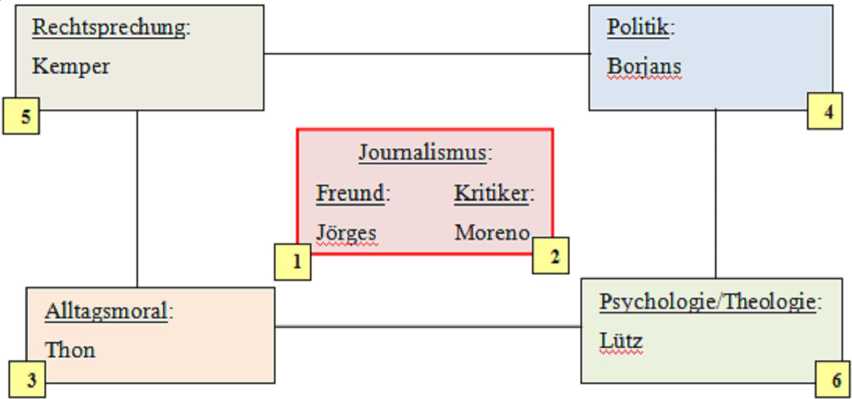
Die nachstehende Skizze veranschaulicht dieses Geflecht: Grafik: Positionierungsgeflecht
positioniert: beispielsweise als der Journalist, die ehemalige Staatsanwältin oder der Finanzminister.
Dass es dabei unter dem Deckmantel der egalitären und anscheinend immer gleichen Präsentation der Gäste zu erkennbar unterschiedlichen Positionierungen und damit verbundenen „Moralisierungen” kommt, darf also nicht als emergentes Phänomen authentischer Interaktion missverstanden werden. Es ist vielmehr die bewusste Konstruktion von Positionierungs-Differenz mittels rekurrenter Reproduktion eines strukturell gleichbleibenden Präsentationsmusters.
ANMERKUNGEN
-
1 Dieser Aufsatz ist im Rahmen des Projekts Nr. 14-04-00147 der „Russian Foundation for Humanities” entstanden. Wir danken Reinhard Fiehler und Wilfried Schütte für konstruktive Kritik und relevante Hinweise.
-
2 Es geht uns also nicht im engeren Sinne um eine produktionsanalytische Perspektive. Zu produktionsanalytischen Aspekten siehe beispielsweise Schmidt [41], Klug/Schmidt [24], Schütte [48] und [49] sowie Bente/Fromm [1]. Zur rezeptionsanalytischen Perspektive – auf die wir hier ebenfalls nicht eingehen können – siehe zum Beispiel Jurga [25].
-
3 Gelegentliche werden jedoch auch medienunerfahrene Betroffene eingeladen. Diese werden dann nicht selten in einer Art „Schonraum” positioniert (räumlich und von der Fragetechnik her) und mit erkennbarer Empathie von den Moderator/ innen behandelt.
-
4 Die Idealisierung der „Reziprozität der Perspektiven” Schütz [50] als eine der basalen Voraussetzungen von Interaktion greift also hier nicht automatisch, sondern muss produzentenseitig aktiv bearbeitet werden.
-
5 Es gibt jedoch Internetforen, in denen gelegentlich schon vor der Sendung über die Zusammensetzung der Gästerunde und die Erwartungen an einzelne Gäste diskutiert wird. So wird der Maybrit-Illner-Teaser in der ZDF-Mediathek und auch aufYouTube kommentiert mit „Reden Sie jetzt mit – gerne auch per Mail“.
-
6 Vor allem Deppermann [10] bietet eine historisch orientierte, systematische Darstellung des Positionierungsansatzes, Schmitt/Knöbl [44] richten das monomodal-verbale Konzept „Recipient Design“ der Konversationsanalyse Sacks [36], Sacks/Schegloff/ Jefferson [35] und Malone [28] multimodal neu aus.
-
7 Die deutsche Entwicklung der multimodalen Interaktionsanalyse ist repräsentiert in den systematischen Sammelbänden Schmitt [42],
Mondada/Schmitt [54], Hausendorf/Mondada/Schmitt [33] und in Schmitt [44]. Zur Differenzierung von multimodaler Interaktionsanalyse und multimodaler Konversationsanalyse siehe Schmitt [43].
-
8 Die Sendung wurde am 29.05.2014 mit dem Titel „Helden, Hoeneß, Hass und Häme - Kennen wir keine Gnade mehr?“ im ZDF ausgestrahlt.
-
9 Die Fokussierung auf Interaktionsanfänge hat in der Konversationsanalyse eine tief gegründete Tradition. Die detaillierte Analyse von Telefoneröffnungen Schegloff [39; 40] ist von der Entwicklung der konversationsanalytischen Methodologie nicht zu trennen. Eröffnungen wurden dann auch für die Analyse von Arzt-Patient-Interaktion auf der Basis gemeinsamer Anwesenheit und wechselseitiger Wahrnehmung Heath [15] oder für alltägliche Situationen Schmitt [46] genutzt. Auch die multimodale Interaktionsanalyse hat Strukturen von Situationseröffnungen analysiert (beispielsweise Mondada/Schmitt [54]).
-
10 Der Rahmen in Bild 11 zeigt in etwa den bei der Präsentation der andern Gäste produzierten Endausschnitt.
-
11 In alltagsweltlicher Formulierung könnte man hier vom „Katzentisch” sprechen, und es drängt sich die Frage auf: Hat die ehemalige Staatsanwältin, nachdem sie die Seiten gewechselt hat, keinen Platz mehr am Tisch der „moralisch Integren” gefunden? Wenn ja, wäre das wesentlich mehr als eine durch das Format bedingte Koinzidenz. Es würde der verdeckten moralischen Position der Macher Ausdruck verleihen und die Vertreterin von Mandanten, die wegen Steuerhinterziehung angeklagt sind, nahe an ihre Mandanten – und damit auch an Hoeneß – rücken.
-
12 Die Sigle „SO“ bezeichnet die Stimme aus dem Off. Das Transkript wurde in Anlehnung an die Konventionen von GAT 2 Selting/Auer et al. [52] erstellt. Die Zuordnung von Bild und verbalen Aktivitäten wird im Transkript durch Fettmarkierung ausgewiesen.
-
13 Zur Relevanzgewichtung oppositiver Relationen in komplexen Äußerungen siehe Kallmeyer/ Schmitt [21].
LITERATURLISTE
POSITIONING GUESTS IN A MAYBRIT ILLNER TALK SHOW
Reinhold Schmitt
Institute of the German Language
R 5, 6-13, D-68161 Mannheim, Germany
Anna Aleksandrovna Petrova
ПОЗИЦИОНИРОВАНИЕ ГОСТЕЙ В ТОК-ШОУ МАЙБРИТ ИЛЛНЕР
Райнхольд Шмитт
Доктор социологии, научный сотрудник отделения прагматики,
Список литературы Positioning guests in a Maybrit Illner talk show
- Bente G., Fromm B. Affektfernsehen. Motive, Angebotsweisen und Wirkungen . Vol. 24. Opladen, Leske und Budrich Publ., 1997. 451 p.
- Boulevard Bio: die ersten zehn Jahre . Hg. Heinz K. M. Köln, Kiepenheuer und Witsch Publ., 2001. 256 p.
- Brinker K. Thematische Muster und ihre Realisierung in Talkshowgesprächen . Zeitschrift für Germanistische Linguistik , 1988, vol. 16/1, pp. 26-45.
- Burger H. Das Gespräch in den Massenmedien . Berlin, New York, de Gruyter Publ., 1991. 438 p.
- Calsamiglia H., Cots J.M. et al. Communicative strategies and socio-cultural identities in talk shows. Pragmatics, 1995, vol. 5/3, pp. 325-339.
- Daily Talkshows: Untersuchungen zu einem umstrittenen TV-Format . Hg. Gerhards C., Möhrmann R. Frankfurt am Main, Lang Publ., 2002. 180 p.
- Das große Rhabarbern. Neununddreißig Fallstudien über die Talkshow . Hg. Roth J., Bittermann K. Berlin, Edition Tiamat Publ., 1996. 191 p.
- Daubach S. Linguistische Aspekte der Analyse von Talkshows am Beispiel der Talkshow “Arabella” . Taunusstein, Driesen Publ., 2008. 164 p.
- Deppermann A. How to get a grip on identitiesin-interaction: (What) Does ‘positioning’ offer more than ‘membership categorization’? Evidence from a mock story. Narrative Inquiry, 2013, vol. 23/1, pp. 62-88.
- Deppermann A. Positioning. Handbook of Narrative Analysis. Eds. De Fina A., Georgakopoulou A. New York, Wiley-Blackwell Publ., 2015, pp. 369-387.
- Dreischer A. “Sie brauchen mich nicht immer zu streicheln... ”: Eine diskursanalytische Untersuchung zu den Funktionen von Berührungen in medialen Gesprächen . Frankfurt am Main, Lang Publ., 2001. 332 p.
- Fley M. Talkshows im deutschen Fernsehen. Konzeptionen und Funktionen einer Sendeform . Bochum, Brockmeyer Publ., 1997. 218 p.
- Franke W. Medienspezifische Dialogsorten . Dialoganalysen II. Hg. Hundsnurscher F., Weigand E. Tübingen, Niemeyer Publ., 1989, pp. 161-173.
- Haag L.L. Oprah Winfrey: the construction of intimacy in the talk show setting. Journal of Popular Culture, 1993, vol. 26/4, pp. 115-121.
- Heath Ch. Body movement and speech in medical interaction. Cambridge, Cambridge University Press, 1986. 200 p.
- Hess-Lüttich E. Dialogsorten: Mediengespräche . Dialoganalysen II. Hg. Hundsnurscher F., Weigand E. Tübingen, Niemeyer Publ., 1989, pp. 175-189.
- Holly W., Schwitalla J. Explosiv -Der heiße Stuhl: Streitkultur im kommerziellen Fernsehen . Kulturinszenierungen . Hg. Müller-Doohm S., Neumann-Braun K. Frankfurt am Main, Suhrkamp Publ., 1995, pp. 59-88.
- Holly W. Imagearbeit in Gesprächen: Zur linguistischen Beschreibung des Beziehungsaspekts . Tübingen, Niemeyer Publ., 1979. 270 p.
- Holly W. Zur Inszenierung von Konfrontation in politischen Fernsehinterviews . Inszenierte Information . Hg. Grewenig A. Opladen, Westdeutscher Publ., 1993, pp. 164-197.
- Jonas C. Das sprachliche Verhalten von Moderatoren in Talk-und Quizshows: eine diskursanalytische Untersuchung zu Frageverhalten und Wortwahl . Frankfurt am Main, Lang Publ., 2006. 183 p.
- Kallmeyer W., Schmitt R. Die Markierung von oppositiven Relationen in komplexen Äußerungen . Mannheim, Institut für Deutsche Sprache Publ., 1991. 200 p.
- Kallmeyer W., Schmitt R. Forcieren oder: Die verschärfte Gangart. Zur Analyse von Kooperationsformen im Gespräch . Gesprächsrhetorik. Rhetorische Verfahren im Gesprächsprozeß. (Studien zur deutschen Sprache, Band 4) . Tübingen, Narr Publ., 1996, pp. 20-118.
- Kalverkämper H. Talk-Show -Eine Gattung in der Antithese . Fernsehsendungen und ihre Formen. Typologie, Geschichte und Kritik des Programms in der Bundesrepublik Deutschland . Hg. Kreuzer H., Prümm K. Stuttgart, Reclam Publ., 1979, pp. 406-426.
- Klug D., Schmidt A. Scripted Reality-Formate im deutschsprachigen Fernsehprogramm. Trinationale Programmanalyse und Konzeption einer kombinierten Produkt-und Produktionsanalyse . Studies in Communication Sciences, 2014, vol. 14/2, pp. 108-120.
- Lindenstraße. Produktion und Rezeption einer Erfolgsserie . Hg. Jurga M. Opladen, Westdeutscher Publ., 1995. 241 p.
- Linke A. Gespräche im Fernsehen . Bern, Frankfurt am Main, Peter Lang Publ., 1985. 287 p.
- Lucius-Hoene G., Deppermann A. Narrative Identität und Positionierung . Gesprächsforschung -Online-Zeitschrift zur verbalen Interaktion , 2004, no. 5, pp. 166-183. Available at: http://www.gespraechsforschungozs. de (accessed 10 November 2015).
- Malone M.J. Worlds of talk. The presentation of self in everyday conversation. Cambridge, Polity Publ., 1997. 182 p.
- Mühlen U. Talk als Show. Eine linguistische Untersuchung der Gesprächsführung in den Talkshows des deutschen Fernsehens . Bern, Frankfurt am Main, Peter Lang Publ., 1985. 344 p.
- Penz H. Language and Control in American TV Talk shows. Tübingen, Narr Publ., 1996. 192 p.
- Plake K. Talkshows: Die Industrialisierung der Kommunikation . Darmstadt, Primus Publ., 1999. 176 p.
- Priest P.J. Public Intimacies: Talk Show Participants and Tell-All TV. Cresskill, N.J., Hampton Press, 1995. 246 p.
- Raum als interaktive Ressource . Studien zur deutschen Sprache, Band 62. Forschungen des Instituts für deutsche Sprache . Hg. Hausendorf H., Mondada L., Schmitt R. Tübingen, Narr Publ., 2012. 436 p.
- Redeshows -Fernsehdiskussionen in der Diskussion . Hg. Holly W., Kühn P., Püschel U. Tübingen, Niemeyer Publ., 1989. 162 p.
- Sacks H., Schegloff E.A., Jefferson G. A simplest systematics for the organization of turn-taking in conversation. Language, 1974, vol. 50/4, pp. 696-735.
- Sacks H. Lectures on conversation. Oxford, Blackwell Publ., 1992, vol. 1, 818 p.; vol. 2, 580 p.
- Sacks H. On the analyzability of stories by children. Directions in sociolinguistics: The ethnography of speaking. Åds. Gumperz J., Hymes D. New York, Holt, Rinehart and Winston Publ., 1972, pp. 325-345.
- Schegloff E.A. A tutorial on membership categorization. Journal of Pragmatics, 2007, vol. 39/3, pp. 462-482.
- Schegloff E.A. Sequencing in conversational opening. American Anthropologist, 1968, vol. 70, pp. 1075-1095.
- Schegloff E.A. The first five seconds: The order of conversational openings. PhD dissertation. University of California, Berkeley, 1967.
- Schmidt A. Das Reality-Prinzip. Programmatisches Plädoyer für die Kombination produkt-und produktionsanalytischer Zugänge in der Erforschung faktualer TV-Formate . Medien & Kommunikationswissenschaft , 2012, no. 3, pp. 362-391.
- Schmitt R. Koordination. Analysen zur multimodalen Interaktion (Studien zur deutschen Sprache, Band 38) . Tübingen, Narr Publ., 2007. 446 p.
- Schmitt R. Positionspapier: Ko-Konstruktionen aus Sicht der multimodalen Interaktionsanalyse . Ko-Konstruktionen als interaktive Verfahren . Åds. Dausendschön-Gay U., Gülich E., Krafft U. Bielefeld, Transcript Publ., 2015, pp 43-51.
- Schmitt R., Knöbl R. „Recipient Design“ aus multimodaler Sicht . Deutsche Sprache , 2013, vol. 41/2, pp. 242-276.
- Schmitt R., Knöbl R. Recipient Design: Zur multimodalen Repräsentation des Anderen im eigenen Verhalten . Mannheim, Open Access Publikationsserver des IDS, 2014. 110 p. Available at: http://ids-pub.bszbw.de/frontdoor/index/index/docId/3239 (accessed 13 November 2015).
- Schmitt R. „So so, ganz fremde Leute stehen da”. Sprachverwendung und soziale Bedeutung in Situationseröffnungen . Deutsche Sprache , 1990, vol. 18/4, pp. 289-309.
- Schultz T. Geschwätz oder Diskurs? Die Rationalität politischer Talkshows im Fernsehen . Köln, Halem Publ., 2006. 400 p.
- Schütte W. Der Mediendiskurs am Beispiel der politischen Talkshow „Hart aber fair” im deutschen Fernsehen . Mediensprache und Medienkommunikation im interdisziplinären und interkulturellen Vergleich . Åd. Volodina M.N. Mannheim, Institut für Deutsche Sprache Publ., 2013, pp. 201-222.
- Schütte W. „die sendung hängt mir NACH, sie GEHT mir noch nach”. Autoreflexive Talkshows . Perspektiven auf Kommunikation. Festschrift für Liisa Tiittula zum 60. Geburtstag . Åds. Kallmeyer W., Reuter E., Schopp J. Berlin, SAXA Publ., 2010, pp. 139-162.
- Schütz A. Gesammelte Aufsätze, Band 1: Das Problem der sozialen Wirklichkeit . The Hague, Martin Nijhoff Publ., 1971. 472 p.
- Seifried B. Talkshow als Subjekt-Diskurs. Sprachliche und interaktive Verfahren und Strategien einer diskursspezifischen Konstruktion von Subjektpositionen in US-amerikanischen Talk-Service-Shows . Frankfurt am Main, 2003. 267 p. Available at: http://publikationen.ub.unifrankfurt.de/frontdoor/index/index/docId/5596 (accessed 12 November 2015).
- Selting M., Auer P. et al. Gesprächsanalytisches Transkriptionssystem 2 (GAT 2) . Gesprächsforschung -Online-Zeitschrift zur verbalen Interaktion , 2009, vol. 10, pp. 353-402. Available at: www.gespraechsforschung-ozs.de/heft2009/px-gat2.pdf(accessed 12 November 2015).
- Semeria S. Talk als Show -Show als Talk: deutsche und US-amerikanische Daytime-Talkshows im Vergleich . Wiesbaden, Opladen Publ., 1999. 255 p.
- Situationseröffnungen: Zur multimodalen Herstellung fokussierter Interaktion . Hg. Mondada L., Schmitt R. Tübingen, Narr Publ., 2010. 386 p.
- Stokoe E. Doing actions with identity categories: Complaints and denials in neighbour disputes. Text and Talk, 2009, vol. 29/1, pp. 75-97.
- Stokoe E. Moving forward with membership categorization analysis: Methods for systematic analysis. Discourse Studies, 2012, vol. 14/3, pp. 277-303.
- Tarsia J. Genderlinguistische Untersuchungen von Talkshows: Am Beispiel Maischberger und Plasberg . Dr. Müller Publ., 2010. 84 p.
- Tenscher J. Talk auf allen Kanälen: Angebote, Akteure und Nutzer von Fernsehgesprächssendungen . Wiesbaden, Westdeutscher Publ., 2002. 412 p.
- Wolf R. Soziale Positionierung im Gespräch . Deutsche Sprache , 1999, no. 1, pp. 69-94.

